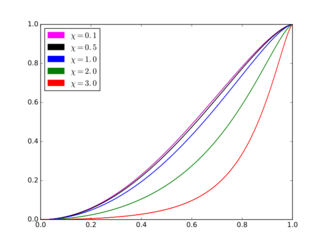ARGUS distribution
|
Probability density function  c = 1. | |||
|
Cumulative distribution function  c = 1. | |||
| Parameters |
[math]\displaystyle{ c \gt 0 }[/math] cut-off (real) [math]\displaystyle{ \chi \gt 0 }[/math] curvature (real) | ||
|---|---|---|---|
| Support | [math]\displaystyle{ x \in (0, c)\! }[/math] | ||
| see text | |||
| CDF | see text | ||
| Mean |
[math]\displaystyle{ \mu = c\sqrt{\pi/8}\;\frac{\chi e^{-\frac{\chi^2}{4}} I_1(\tfrac{\chi^2}{4})}{ \Psi(\chi) } }[/math] where I1 is the Modified Bessel function of the first kind of order 1, and [math]\displaystyle{ \Psi(x) }[/math] is given in the text. | ||
| Mode | [math]\displaystyle{ \frac{c}{\sqrt2\chi}\sqrt{(\chi^2-2)+\sqrt{\chi^4+4}} }[/math] | ||
| Variance | [math]\displaystyle{ c^2\!\left(1 - \frac{3}{\chi^2} + \frac{\chi\phi(\chi)}{\Psi(\chi)}\right) - \mu^2 }[/math] | ||
In physics, the ARGUS distribution, named after the particle physics experiment ARGUS,[1] is the probability distribution of the reconstructed invariant mass of a decayed particle candidate in continuum background[clarification needed].
Definition
The probability density function (pdf) of the ARGUS distribution is:
- [math]\displaystyle{ f(x; \chi, c ) = \frac{\chi^3}{\sqrt{2\pi}\,\Psi(\chi)} \cdot \frac{x}{c^2} \sqrt{1-\frac{x^2}{c^2}} \exp\bigg\{ -\frac12 \chi^2\Big(1-\frac{x^2}{c^2}\Big) \bigg\}, }[/math]
for [math]\displaystyle{ 0 \leq x \lt c }[/math]. Here [math]\displaystyle{ \chi }[/math] and [math]\displaystyle{ c }[/math] are parameters of the distribution and
- [math]\displaystyle{ \Psi(\chi) = \Phi(\chi)- \chi \phi( \chi ) - \tfrac{1}{2} , }[/math]
where [math]\displaystyle{ \Phi(x) }[/math] and [math]\displaystyle{ \phi( x ) }[/math] are the cumulative distribution and probability density functions of the standard normal distribution, respectively.
Cumulative distribution function
The cumulative distribution function (cdf) of the ARGUS distribution is
- [math]\displaystyle{ F(x) = 1 - \frac{\Psi\left(\chi\sqrt{1-x^2/c^2}\right)}{\Psi(\chi)} }[/math].
Parameter estimation
Parameter c is assumed to be known (the kinematic limit of the invariant mass distribution), whereas χ can be estimated from the sample X1, …, Xn using the maximum likelihood approach. The estimator is a function of sample second moment, and is given as a solution to the non-linear equation
- [math]\displaystyle{ 1 - \frac{3}{\chi^2} + \frac{\chi\phi(\chi)}{\Psi(\chi)} = \frac{1}{n}\sum_{i=1}^n \frac{x_i^2}{c^2} }[/math].
The solution exists and is unique, provided that the right-hand side is greater than 0.4; the resulting estimator [math]\displaystyle{ \scriptstyle\hat\chi }[/math] is consistent and asymptotically normal.
Generalized ARGUS distribution
Sometimes a more general form is used to describe a more peaking-like distribution:
- [math]\displaystyle{ f(x) = \frac{2^{-p}\chi^{2(p+1)}}{\Gamma(p+1)-\Gamma(p+1,\,\tfrac{1}{2}\chi^2)} \cdot \frac{x}{c^2} \left( 1 - \frac{x^2}{c^2} \right)^p \exp\left\{ -\frac12 \chi^2\left(1-\frac{x^2}{c^2}\right) \right\}, \qquad 0 \leq x \leq c, \qquad c\gt 0,\,\chi\gt 0,\,p\gt -1 }[/math]
- [math]\displaystyle{ F(x) = \frac{\Gamma\left(p+1,\,\tfrac{1}{2}\chi^2\left( 1 - \frac{x^2}{c^2} \right)\right)-\Gamma(p+1,\,\tfrac{1}{2}\chi^2)}{\Gamma(p+1)-\Gamma(p+1,\,\tfrac{1}{2}\chi^2)}, \qquad 0 \leq x \leq c, \qquad c\gt 0,\,\chi\gt 0,\,p\gt -1 }[/math]
where Γ(·) is the gamma function, and Γ(·,·) is the upper incomplete gamma function.
Here parameters c, χ, p represent the cutoff, curvature, and power respectively.
The mode is:
- [math]\displaystyle{ \frac{c}{\sqrt2\chi}\sqrt{(\chi^2-2p-1)+\sqrt{\chi^2(\chi^2-4p+2)+(1+2p)^2}} }[/math]
The mean is:
- [math]\displaystyle{ \mu=c \,p \, \sqrt{\pi}\frac{\Gamma(p)}{\Gamma(\tfrac{5}{2}+p)}\frac{\chi^{2p+2}}{2^{p+2}}\frac{M\left(p+1,\tfrac{5}{2}+p,-\tfrac{\chi^2}{2}\right)}{\Gamma(p+1)-\Gamma(p+1,\,\tfrac{1}{2}\chi^2)} }[/math]
where M(·,·,·) is the Kummer's confluent hypergeometric function.[2][circular reference]
The variance is:
- [math]\displaystyle{ \sigma^2=c^2 \frac{\left(\frac{\chi}{2} \right)^{p+1}\chi^{p+3}e^{-\tfrac{\chi^2}{2}}+\left(\chi^2-2(p+1)\right)\left\{\Gamma(p+2)-\Gamma(p+2,\,\tfrac{1}{2}\chi^2)\right\}} {\chi^2(p+1)\left(\Gamma(p+1)-\Gamma(p+1,\,\tfrac{1}{2}\chi^2)\right)}-\mu^2 }[/math]
p = 0.5 gives a regular ARGUS, listed above.
References
- ↑ Albrecht, H. (1990). "Search for hadronic b→u decays". Physics Letters B 241 (2): 278–282. doi:10.1016/0370-2693(90)91293-K. Bibcode: 1990PhLB..241..278A. (More formally by the ARGUS Collaboration, H. Albrecht et al.) In this paper, the function has been defined with parameter c representing the beam energy and parameter p set to 0.5. The normalization and the parameter χ have been obtained from data.
- ↑ Confluent hypergeometric function
Further reading
- Albrecht, H. (1994). "Measurement of the polarization in the decay B → J/ψK*". Physics Letters B 340 (3): 217–220. doi:10.1016/0370-2693(94)01302-0. Bibcode: 1994PhLB..340..217A.
- Pedlar, T.; Cronin-Hennessy, D.; Hietala, J.; Dobbs, S.; Metreveli, Z.; Seth, K.; Tomaradze, A.; Xiao, T. et al. (2011). "Observation of the hc(1P) Using e+e− Collisions above the DD Threshold". Physical Review Letters 107 (4): 041803. doi:10.1103/PhysRevLett.107.041803. PMID 21866994. Bibcode: 2011PhRvL.107d1803P.
- Lees, J. P.; Poireau, V.; Prencipe, E.; Tisserand, V.; Garra Tico, J.; Grauges, E.; Martinelli, M.; Palano, A. et al. (2010). "Search for Charged Lepton Flavor Violation in Narrow Υ Decays". Physical Review Letters 104 (15): 151802. doi:10.1103/PhysRevLett.104.151802. PMID 20481982. Bibcode: 2010PhRvL.104o1802L.
 |

